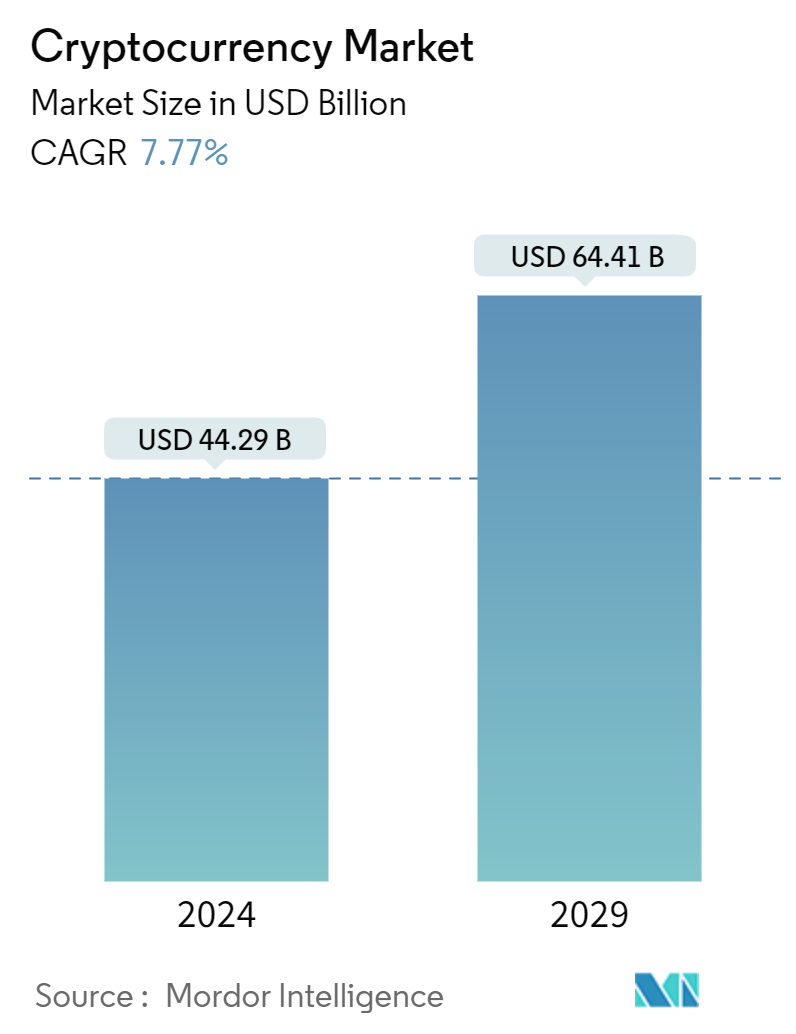Market Size of Cryptocurrency Industry

| Study Period | 2020 - 2029 |
| Market Size (2024) | USD 44.29 Billion |
| Market Size (2029) | USD 64.41 Billion |
| CAGR (2024 - 2029) | 7.77 % |
| Fastest Growing Market | North America |
| Largest Market | Europe, Middle-East and Africa |
Major Players
*Disclaimer: Major Players sorted in no particular order |
Need a report that reflects how COVID-19 has impacted this market and its growth?
Cryptocurrency Market Analysis
The Cryptocurrency Market size is estimated at USD 44.29 billion in 2024, and is expected to reach USD 64.41 billion by 2029, growing at a CAGR of 7.77% during the forecast period (2024-2029).
Cryptocurrency, or virtual currency, operates solely in the digital realm without any overseeing regulatory body. Utilizing distributed ledger technology like blockchain and cryptocurrency ensures transaction validation. The surge in distributed ledger technology adoption is forecasted to drive growth in the cryptocurrency market. Additionally, the rising use of cryptocurrencies for cross-border remittances is projected to expand the market by lowering consumer fees and exchange costs. The market capitalization of numerous cryptocurrencies is used to segment the cryptocurrency market. These digital currencies intersect with crucial aspects of the monetary and financial systems. Due to their rapid expansion, intricate nature, significant fluctuations, and potential for enabling unlawful transactions, regulators and policymakers worldwide express apprehension regarding their integration into the current system and the need to adapt the system accordingly.
Cryptocurrencies, developed initially to facilitate peer-to-peer transactions independent of government or central bank oversight, have emerged as a cutting-edge financial innovation. These digital assets are currently under examination to assess their potential risks and rewards within the financial industry and their diverse design objectives. There are numerous cryptocurrencies, each serving a specific purpose. Some seek an alternative to traditional currency (such as Bitcoin, Monero, and Bitcoin Cash), while others focus on supporting cost-effective payment systems (like Ripple, Particl, and Utility Settlement Coin). Additionally, specific cryptocurrencies enable peer-to-peer trading through token creation (such as RMG and Maecenas), while others provide secure access to goods or services in direct transactions (like Golem and Filecoin). Some cryptocurrencies support underlying platforms or protocols (such as Ether and NEO). It is essential to recognize that new cryptocurrencies are continually being developed, so this list of design objectives is incomplete.
Cryptocurrency Industry Segmentation
Cryptocurrencies are digital currencies that serve as an alternative form of payment, utilizing encryption algorithms for their creation. Cryptocurrencies are both currency and virtual accounting systems that leverage encryption technologies. To engage with cryptocurrencies, a cryptocurrency wallet is required. The report gives an understanding of the present status of the cryptocurrency market, along with detailed market analysis, their structural intricacies explained in simple terms, risks and opportunities, current regulatory frameworks, and impact on existing systems—an in-depth analysis of the implications for monetary and fiscal policies. The cryptocurrency market is segmented by market capitalization of cryptocurrencies and cryptocurrency adoption by geography. By market capitalization of cryptocurrencies, the market is segmented into Bitcoin, Ethereum, Ripple, Bitcoin Cash, Cardano, and others. By cryptocurrency adoption by geography, the market is segmented into the Middle East & Africa, the Americas, Europe, and APAC. The report offers the market sizes and forecast values (USD) for all the above segments.
| By Market Capitalization | |
| Bitcoin | |
| Ethereum | |
| Ripple | |
| Bitcoin Cash | |
| Cardano | |
| Others |
| North America | |
| United States | |
| Canada | |
| Mexico | |
| Rest of North America |
| Europe | |
| United Kingdom | |
| Germany | |
| France | |
| Russia | |
| Italy | |
| Spain | |
| Rest of Europe |
| Asia-Pacific | |
| India | |
| China | |
| Japan | |
| Australia | |
| Rest of Asia-Pacific |
| South America | |
| Brazil | |
| Argentina | |
| Rest of South America |
| Middle East & Africa | |
| United Arab Emirates | |
| South Africa | |
| Rest of Middle East & Africa |
Cryptocurrency Market Size Summary
The cryptocurrency market is experiencing significant growth, driven by the increasing adoption of distributed ledger technology and the rising use of digital currencies for cross-border remittances. Cryptocurrencies operate independently of any regulatory authority, utilizing blockchain technology to validate transactions. This decentralized nature offers advantages over traditional financial systems, such as reduced transaction costs and improved access to financial services, particularly in regions with limited banking infrastructure. The market is characterized by a diverse range of cryptocurrencies, each designed for specific purposes, from serving as alternatives to traditional currencies to facilitating cost-effective payment systems and enabling peer-to-peer trading. The continuous development of new cryptocurrencies further adds to the market's complexity and potential.
North America is expected to be a major contributor to the global cryptocurrency market growth, with the United States leading due to its technological advancements and numerous market players. The region's market expansion is fueled by the growing demand for digital payments and the increasing acceptance of cryptocurrencies as a form of value storage. Investments in blockchain technology and cryptocurrency mining solutions are also on the rise, aiming to enhance efficiency and performance. The market remains highly fragmented, with thousands of cryptocurrencies and significant players like Bitfinex, Quantstamp Inc., CryptoMove Inc., Coinbase, and Huobi Global actively participating. These developments underscore the evolving landscape of the cryptocurrency market, as it continues to gain traction and legitimacy within the global financial system.
Cryptocurrency Market Size - Table of Contents
-
1. MARKET DYNAMICS AND INSIGHTS
-
1.1 Market Overview
-
1.2 Market Drivers
-
1.2.1 Rising Demand for Operational Efficiency and Transparency in Financial Payment Systems
-
1.2.2 Increasing Demand for Remittances in Developing Countries
-
-
1.3 Market Restraints
-
1.3.1 Varying Government Regulations in Different Countries Affecting the Market
-
1.3.2 Volatility in Market Value Increases the Risk of Holding Cryptocurrency
-
-
1.4 Market Opportunities
-
1.4.1 Rising Opportunities for Companies to Create New Digital Assets
-
1.4.2 Cryptocurrency Emerging as an Opportunity to Invest Money with Higher Returns
-
-
1.5 Industry Attractiveness - Porter's Five Forces Analysis
-
1.5.1 Threat of New Entrants
-
1.5.2 Bargaining Power of Buyers
-
1.5.3 Bargaining Power of Suppliers
-
1.5.4 Threat of Substitute Products and Services
-
1.5.5 Intensity of Competitive Rivalry
-
-
1.6 Trends Influencing Global Cryptocurrency Market
-
1.7 Technological Innovations in Global Cryptocurrency Market
-
1.8 Impact of COVID-19 on the Market
-
-
2. MARKET SEGMENTATION AND ANALYSIS
-
2.1 By Market Capitalization
-
2.1.1 Bitcoin
-
2.1.2 Ethereum
-
2.1.3 Ripple
-
2.1.4 Bitcoin Cash
-
2.1.5 Cardano
-
2.1.6 Others
-
-
2.2 Geography
-
2.3 North America
-
2.3.1 United States
-
2.3.2 Canada
-
2.3.3 Mexico
-
2.3.4 Rest of North America
-
-
2.4 Europe
-
2.4.1 United Kingdom
-
2.4.2 Germany
-
2.4.3 France
-
2.4.4 Russia
-
2.4.5 Italy
-
2.4.6 Spain
-
2.4.7 Rest of Europe
-
-
2.5 Asia-Pacific
-
2.5.1 India
-
2.5.2 China
-
2.5.3 Japan
-
2.5.4 Australia
-
2.5.5 Rest of Asia-Pacific
-
-
2.6 South America
-
2.6.1 Brazil
-
2.6.2 Argentina
-
2.6.3 Rest of South America
-
-
2.7 Middle East & Africa
-
2.7.1 United Arab Emirates
-
2.7.2 South Africa
-
2.7.3 Rest of Middle East & Africa
-
-
Cryptocurrency Market Size FAQs
How big is the Cryptocurrency Market?
The Cryptocurrency Market size is expected to reach USD 44.29 billion in 2024 and grow at a CAGR of 7.77% to reach USD 64.41 billion by 2029.
What is the current Cryptocurrency Market size?
In 2024, the Cryptocurrency Market size is expected to reach USD 44.29 billion.

